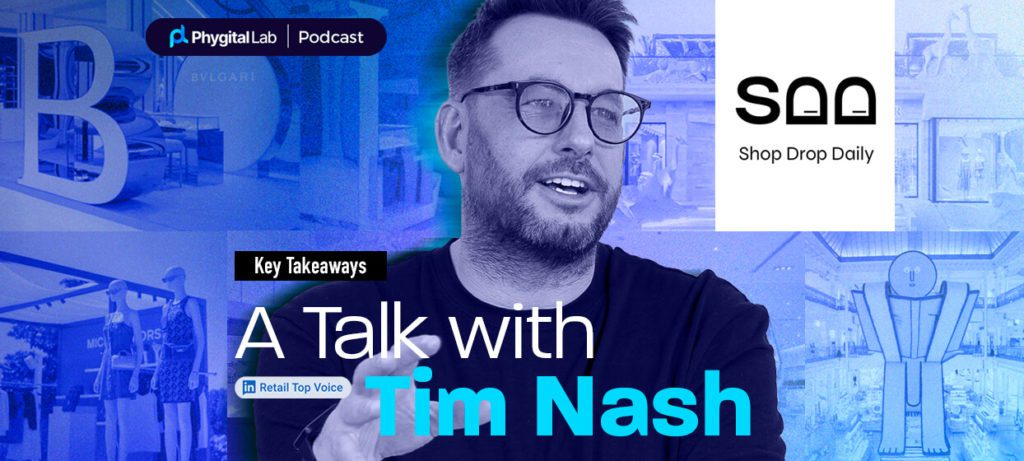
HYPERVSN 3D Catalog
USD 1,200
Qty

HYPERVSN 3D Catalog
USD 1,200
Qty

HYPERVSN 3D Catalog
USD 1,200
Qty
Cart Subtotal:
USD 3,600

Astrid Pocklington
Head of Demand Generation
Retail has evolved. The tradition of physical retail shopping has been turned on its head ever since 2020, when the world had to rethink the common-place act of simply ‘going to the shops’. These days, customers need to be enticed from the convenience of shopping on their smartphones from the comfort of their living rooms, to actively putting on something other than sweatpants and leaving the house to make their purchases.
This adds a whole new level of complexity to Retail, and more specifically, Retail Designers, who in times gone by simply had to make sure the layout of the store was welcoming, thoughtful and navigable. Now, the need for creative problem-solving and technological innovation are key elements that need to focus on driving store visits and enhancing the customer experience, but how can the time old tradition of ‘going to the shops’ and brand new innovative retail design work in harmony to bring in the greatest effect for business?
In order to encourage more physical in-store shopping, brands must create powerful experiences that excite and engage customers. Going one step further and personalising these experiences is the real secret sauce to making your store a sought-after destination, rather than just a stopping point. Tim Nash, a leading Retail Influencer and curator behind the Shop Drop Daily website, says in our latest Phygital Lab podcast ‘Thinking Differently to Meet Rising Expectations’:
After the disruption of the COVID pandemic, this has left brands open to capitalising on huge new opportunities, especially when it comes to data and customer insights. Using consumer apps, website data and real-time store insights, brands that are switched on and able to connect the dots are now showing what it really means to ‘listen to the customer’. Sephora for example is doing a brilliant job of listening to what their customers want, and is using their ‘Beauty Insider Program’ to enhance not only their customers’ online experience, but to guide their retail design innovations for an effortlessly seamless and well connected customer journey. Their digital insights pull from purchase histories, product preferences and more to create virtual makeovers that are unique to each customer, and this allows them to send targeted and hyper-personalised promotions and offers to customers to bring in more revenue and more customer satisfaction than ever before.
IKEA is another great example of how brands are using data and technology to personalise their retail experience. Their ‘Virtual Showroom’ which is an innovative AR platform, uses customer data insights to create virtual showrooms that display how IKEA products will look in the comfort of their own home. An immersive experience that strengthens purchasing motivations, this is a simple yet smart way of combining data and technology to enhance customer engagement and support purchasing decisions for increased revenue and lasting advocacy.
Dulux, the paint company, have done a similar thing with their ‘Visualiser’ app, which uses Augmented reality to display selected paint colours onto the walls of the customers’ home. This hyper-personalised approach to customer engagement not only brings an element of fun and novelty to the table, but also removes any mystery from the purchasing journey, reducing the chances of cart abandonment and increasing the likelihood of purchase.
Bringing interactive digital elements into the modern retail experience is revolutionising the sector in the best ways, answering the demand for a more future-focused and digital customer experience, but also bringing a phygital appeal that demands attention and elicits eager participation.
“[Retail] is finding its feet again […and] the physical store will become less of a transactional space, and […] become a platform for this [personalised] curation”.
– Tim NashPhysical retail spaces are being designed to become spaces where customers go to engage and interact with their favourite brands, to seek out immersive, hyper-personalised and relevant experiences that then drive their purchasing decisions, but are no longer simply showrooms for products.
Audi developed their VR Showroom in order to immerse potential buyers and give them an unforgettable experience that transcends the traditional car showroom experience. By using a VR headset, customers were transported to their ‘ideal car’, customising it with the colours and features they were interested in, in order to get a ‘real feel‘ for their dream car in the comfort of the showroom. A truly dynamic selling technique, this innovative approach to sales pushed the evolution of what a typical car purchasing journey could look like, and even gave users the chance to ‘live out’ a pit-stop experience from the Le Mans 24 Hour race to really get their imagination going and their blood pumping.
Zara utilised AR technology in a similarly innovative fashion. Though only available for a limited time, their window displays gave customers outside the chance to see models wearing Zara fashion as if on a runway in the store window, modelling the latest fashions and designs to onlookers on the street as if they were witness to a very unique runway show. In-store, there were dedicated ‘zones’ where customers could use their smartphones to watch models ‘catwalk’ in front of their eyes the very designs they were looking at purchasing. This was installed in order to give customers a realistic view of how the clothing hung on the body without trying it on themselves, and save them time if they needed to make a quick purchase.
These integrations not only showed off how future-focused and forward thinking these brands are, but gave them a whole new innovative appeal in terms of their retail experience and customer engagement. Both Zara and Audi are huge names in their respective sectors, and by adding digital innovations that speak to the cultural desire for a more digital lifestyle and customer convenience, these contributed to not only enhanced sales but also to improved brand appeal.
Finding the right balance between tradition and innovation in retail design is a tricky one, but one which requires cohesive design and connected thinking that’s focused on the customer from the start. The customer of today is focused on convenience, personal engagement and digital enhancement, but what needs to be ever present in the minds of retail designers is Relevance.
“what are brands doing to immerse […] their audience, […] how [are they creating] that theme that really drives [a] personal connection with the consumer.”
– Tim Nash says on this topicUsing data and insights to find the relevance that connects brands to consumers is the modern cornerstone of retail design, taking it from design conception to digital execution and maintaining that innovation and engagement throughout the customer journey.
Especially when it comes to luxury and heritage brands, the need for relevance with their technological innovation is a paramount concern. These brands are known for their exclusivity, their look and feel when it comes to the architecture of their retail spaces, the feel of their products, the smell of the spaces they’re in, and these are what their customers repeatedly shop with them for. This experience cannot be diluted by technology, it needs to be enhanced by it, and innovations such as AR and interactive tech have the ability to do just that.
Chanel, the french fashion powerhouse, is such an example where they have begun implementing AI into their stores in the form of AI-powered virtual assistants that work with clients using their virtual try-on tool. This tool works alongside clients and suggests beauty products that will complement their outfit choices, which brings convenience, luxury customer service and innovative engagement to the forefront of an already exclusive experience. By incorporating such an intelligent yet subtle digital innovation in-store, Chanel is able to retain their heritage look and feel that their customers love, but adds a 21st century layer of innovation to their experience.
Maintaining authenticity is key to luxury brands’ success, but the need to embrace innovation is a rising importance in this modern age. AI is central to the success of these brands, and implementing it in thoughtful, creative and cohesive ways throughout the customer journey is how they will continue to succeed. Whether it’s through AI-powered sales assistants, virtual try-on mirrors or immersive retail zones where the consumer is plunged into an exciting world of storytelling brand activations, taking them on a journey through the history of the brand, these initiatives are what will continue to drive the exclusivity and appeal that has given these brands the status they hold today.
Authenticity, relevance and connected, creative thinking are what drive the future of modern retail design. From utilising customer data in hyper-personalised manners from promotional app offerings to in-store executions, offering intensely detailed and authentic phygital customer experiences and really taking the time to consider what it is that customers continue to shop with brands for and amplifying that in innovative and relevant ways, these are the new pillars of success for brands. Heritage or not, these are what will continue to pull people from their comfortable world of home-based online shopping and back to retail in-store experiences that build not just revenue for brands, but dramatically enhance their brand appeal and engagement as well.
Finding the perfect balance between what makes your brand appealing to your customers and what technological innovations can amplify that appeal, will be the sweet spot that people are searching for. A tactic that showcases your retail design creativity in such a dynamic and ever-changing market, and keeps you ahead of your competition.



subscribe

USD 1,200
Qty

USD 1,200
Qty

USD 1,200
Qty
Cart Subtotal:
USD 3,600☎️
“For me, the point of it is how you create that thing that really drives […] a connection, a personal connection with the consumer”. It’s a brand new world for Retail, and with eCommerce and online initiatives pulling more and more people away from the high street, creatives like Tim are having to think in a very new, holistic and story-centric manner. “[Retail design] has kind of [done a] 180 [° spin], […] which becomes a challenge because it needs so much more connected thinking from the beginning. And what’s really exciting for me is it used to be driven out by the campaign, for example. Now I think we’re flipping it [so] that the story drives it.”